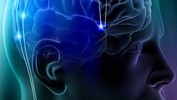/
The usually paired ovaries of female vertebrates produce both the sex cells and the hormones necessary for reproduction. In some invertebrate groups suchas coelenterates, formation of ovaries is associated with the seasons. Many invertebrates have both ovaries and testes in one animal, and some species undergo sex reversal.
In humans, ovaries of the newborn and young child are a mass of elongated tissue; as the female reaches adolescence, the ovaries gradually enlarge and change their shape. The adult ovaries are almond-shaped and are about 4 centimetres (1.6 inches) long, 2 centimetres (0.8 inch) wide, and 1.5 centimetres (0.6 inch) thick; the two ovaries weigh from 4 to 8 grams (0.15 to 0.3 ounce).
The ovaries are attached to the uterus and the fallopian tubes by several ligaments. The surfaces of the ovaries are usually uneven and have areas of scar tissue. Hollow balls of cells—follicles—containing immature egg cells are present in the ovaries at birth; there are usually 150,000 to 500,000 follicles at this time.
When the female reaches adolescence and young adulthood, the number has been reduced to only about 34,000. As a woman ages, the follicles gradually diminish in number until,at menopause and the cessation of reproductive powers, the few remaining follicles degenerate.During the active child-bearing years, normally between the ages 13 and 50, only 300 to 400 of the follicles undergo maturation. In about every four weeks of the active reproductive years, one follicle from only one of the two ovaries matures; the egg inside the follicle is extruded from the ovary into the rest of the reproductive tract for fertilization. If the egg is not fertilized by the male sperm, it passes from the body during theprocess of menstruation.
The ovaries also function asendocrine glandsby secreting two hormones,estrogen and progesterone, into the bloodstream. Estrogen, which is secreted by the ovarian follicle, controls the development of the secondary sex characteristics such as enlargement of the breasts, growth of pubic hair, and the increased amount of fat on the hips and buttocks; estrogen also stimulates growth of the uterine lining during the menstrual cycle.Progesteroneis secreted from the cells of thecorpus luteum, a body that develops at the site of the mature follicle upon release of the egg. Progesterone helps the fertilized egg to secure itself to the uterus and to develop into an embryo.
The centre of the ovary, called themedulla, is a core of connective tissue consisting of blood vessels, lymphatic ducts, and nerve fibres. The thick layer covering the medulla is the cortex, which contains the follicles and ova. As a follicle matures, it enlarges and migrates to the surface of the ovary.
When an egg is discharged from a follicle, blood and yellow cells move into the empty follicular cavity to fill it; this tissue becomes the corpus luteum. If the egg is fertilized, the corpus luteum remains until the end of pregnancy; during this time the corpus luteum secretes progesterone. If the ovum is not fertilized,the corpus luteum becomes a whitish scar mass, known as corpus albicans,which, usually, eventually disappears.
After menopause, the ovariesshrink in size and usually consist of old fibrous tissue. The production of estrogen drops considerably but does not totally cease.
Click Here To Discover How to Treat Infertility Naturally; Without Drugs or Surgery . The Pregnancy MiracleTM System .



